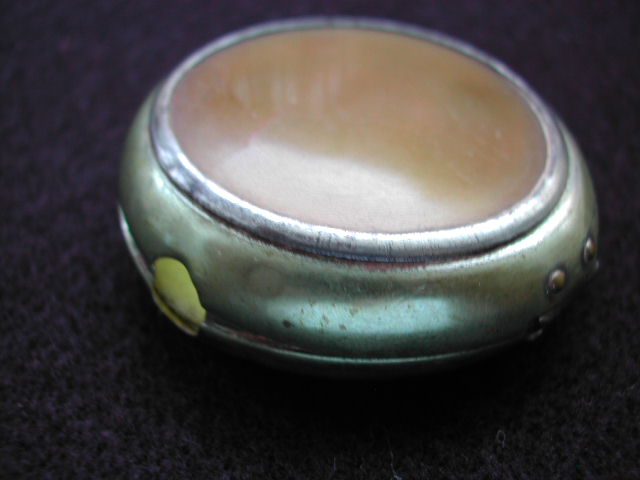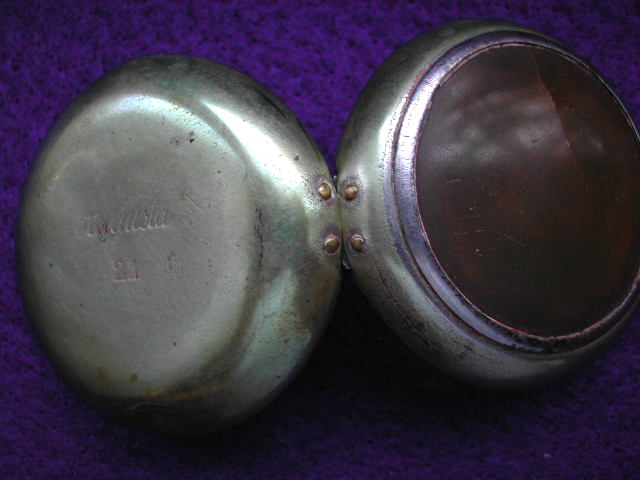
| WWT Shows | CLICK TO: Join and Support Internet Horology Club 185™ | IHC185™ Forums |

|
• Check Out Our... • • TWO Book Offer! • |
Welcome Aboard IHC185™  Internet Horology Club 185
Internet Horology Club 185  IHC185™ Discussion Site Main Page
IHC185™ Discussion Site Main Page  Horological Discussions, Questions and Answers
Horological Discussions, Questions and Answers  Pocket Watch Discussions
Pocket Watch Discussions  The Working Man's Case
The Working Man's Case
 Internet Horology Club 185
Internet Horology Club 185  IHC185™ Discussion Site Main Page
IHC185™ Discussion Site Main Page  Horological Discussions, Questions and Answers
Horological Discussions, Questions and Answers  Pocket Watch Discussions
Pocket Watch Discussions  The Working Man's Case
The Working Man's CaseGo  | New Topic  | Find-Or-Search  | Notify  | Tools  | Reply to Post  |  |
You learn as you go. Sounds familiar? So truer words are spoken as I've learned about the working man's case. Here's a bit of information I'd like to share with you. In the 1500's, time could be viewed through rock crystal cases and pierced lid watches, pre-cursors to and same principle as demi-hunter watches. Unlike demi-hunter watches, a hunter's case must be opened to tell time. We can trace the meaning of "pair-cases", a protective outer case for use when traveling, as early as the first half of the 17th century. Pair-cases were used to protect a watch from dust as the inner case could not be dustproof since it provided access to the winding and setting key holes in the watch case. Pair-cases were made of leather and sometimes decoratively tooled. At one point, decorations were so lavish one needed a third case to protect the second, turning full circle. Pair-cases became known as the working man's case and were made of german silver, gun metal, color alloys, or metallic gold colors. Protective cases for ladies were more often made of tortoise shell. The working man's case served two purposes, to view time and to protect finely engraved precious gold or sterling silver cases from scratching, abrasions, or breakage during the daily "work-a-day" routine, hence the name "working man's case. Unlike pair-cases, watches were rarely removed from the working man's case since a watch could be wound and sometimes even set while still in the case. Beauty is certainly not exemplified in working mans cases since they saw their share of physical abuse in their day and as evidenced in my collection. These cases served their purpose though, as they preserved many beautiful watch cases, movements and dials. At the time of purchase, my very first working man's case  | |||
|
housed a beautifully etched silver 8s case, marked "D.v.d Nykerk on dial. The words "Augusta 21" are printed on the back of brass hinged case. Stephanie O'Neil  | ||||
|
I've added only a few to my collection since, as they are seldom seen in today's market. Here's an inside look at my collection of working man's cases! A front view of a roman numeraled brass hinged case with glass insert. Holds a 12s. Stephanie O'Neil  | ||||
|
An inside view of case. Stephanie O'Neil  | ||||
|
Here's a front view of an ornately decorated brass hinged, and clasped locket watch case. Holds a 0s watch. Stephanie O'Neil  | ||||
|
Another view. Stephanie O'Neil  | ||||
|
Back view Stephanie O'Neil  | ||||
|
An aluminum(?) working man's case. Holds an 18S Stephanie O'Neil  | ||||
|
Black metal spring hinged working man's case. Holds 18-20S. Stephanie O'Neil  | ||||
|
I'll add to post as my collection grows! Feel free to do the same if you have any working man's cases in your collection or info as well! Some of the finest pocket watches we see and collect today have been preserved thanks to the working man's case! Hope you enjoyed the thread!! Stephanie O'Neil | ||||
|
Here are 2 pictures of the only one I have. It is big and held an English pair case watch complete.. Front cover screws on and it has a thick glass crystal. I believe it was used by miners.. | ||||
|
2nd view... John Pavlik | ||||
|
I just picked this up today and low and behold I find this thread.. pretty interesting case.. Does anyone have more info on them? Was thinking about putting this on ebay.. Bruce Byrd | ||||
|
2nd pic Bruce Byrd | ||||
|
Bruce, I think you should buy mine, find one more then you have a collection... John | ||||
|
mine is also made of brass with a very thick crystal.. I am gonna stick it on ebay and see what comes of it.. Dont have any info on maker or when they were used. Bruce Byrd | ||||
|
see if this works Sheila  | ||||
|
Sheila how do you open it? Does it have a tab or a slot for your thumbnail? Does it have a latch that holds it closed? Does it have a spring? Thanks! Stu Goldstein IHC Member 19 | ||||
|
I have seen a few of these miner cases,I think they were popular in Wales with the coal miners..they are pretty neat. | ||||
|
Hi, It has a hinge, kinda spring like. It looks and feels like bakelite but it is actually made of lead. I would have guessed a form of plastic but it's lead for sure! I got it from the site mentioned above. Ruby Lane a few months ago. I don't think I have a picture of it, but if I do I will post it. I almost purchased the miners case mentioned above too, but got too deep into cases, and display cases I needed to buy it too. It is neat though. Mine has 1889 on the inside and Ajax too, with a number. Sheila | ||||
|
John P., & Bruce B., Your "working man's" miners cases are quite unusual. I've not seen any of this type. Thanks for your posts and added information! Sheila, Thanks for posting a very neat as well as informative ad! My black metal spring hinged case is different from yours in that the front is "see thru". Do others have working man's cases to share with us? Stephanie O'Neil | ||||
|
I forgot to mention that in the above link, if you scroll down and enlarge you will see three pictures, and that it also has a case included. I purchased for the insulator and turned out to be a pretty decent watch case too. I don't know what they are called but it also has 2 crystals, so you can see through the front and the back. Sheila | ||||
|
Sheila, I'm a bit confused. It appears each side of the "insulator" cases do not have a crystal but that the inside watch case that would hold a movement,does. Am I correct? Stephanie O'Neil | ||||
|
Do you think "working man's cases" were used by people who worked on railroads? Stephanie O'Neil | ||||
|
Hi, Sorry, I missed the last two posts. Mine is only the black case that opens by a spring hinge type of device, and the part inside is a regular watch case, with crystals on both sides. That's the way I received it. In the picture about you can see that the case fits inside of it, and mine is like that. The insulator is real light, and you just separate it by opening it holding both sides, and open... it's very easy with the spring hinge, no clasp or anything, let it go and it closes by itself. The case inside is not part of the insulator itself, only the black part is the insulator, and your right, it doesn't have crystals at all. About the people that work on the railroads using them, I doubt it, since most of the watches were timed and set at the station for a long time, then given to the men for use, I think that an insulator would have been a problem since they hung them up in the offices until they were checked and used, and I believe later when they carried them, themselves, they didn't keep them in anything for the sake of convience. So far, that is what I have read. It sounds reasonable to me, so I figure it's probably true. BUT.. I did also read (once) that they DID use them, because of the magnatism issue on trains, so who knows! I'm sure that someone here knows the answer to that one. Sure hope someone answers this one for us. I'm beginning to think that you can't be interested in watches without thinking of cases and things like these too, at least for me, they are part of the entire package. I just hope I can learn the differences in all of them, so that I will know which case go with what watch, while searching for the "just right" protector. Yours are really nice. ps love the background too! Sheila | ||||
|
I just picked up two of the black bakelite cases last week at our chapter mart--one 16S and the other 12S. Both in like new condition. Found them in a box marked anything for $1.00 After seeing what they have sold for guess I scored in a meager way. Tom | ||||
|
Sheila, You said "the part inside is a regular watch case, with crystals on both sides" FYI watch case is called an exhibition or salesmans case. Thanks for your input! Glad you enjoyed background of pics as they are part of a vintage postcard collection I own! Will be putting them to good use for future backdrop in showing watches! What do others think? Tom H., Good find! Stephanie O'Neil | ||||
|
Sheila, P. S. Those postcards you see are all of the New Orleans area. Several are views of Canal St. from the late 1800's and early 1900's. One is a view of the wonderful courtyards from the 30's or 40's. Stephanie O'Neil | ||||
|
Stephanie, Thanks you, I thought that is what it was, I had read about the salesman's cases in some posts here and other places but was not sure. Your post cards are great, and using them as a backdrop is a wonderful idea. I really like the effect on the view too. Sheila | ||||
|
| Powered by Social Strata |
| Your request is being processed... |
|
©2002-2025 Internet Horology Club 185™ - Lindell V. Riddle President - All Rights Reserved Worldwide

